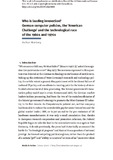Zitierlink:
http://dx.doi.org/10.25819/ubsi/8069Dateien zu dieser Ressource:
| Datei | Beschreibung | Größe | Format | |
|---|---|---|---|---|
| Homberg_Who_is_leading.pdf | 268.6 kB | Adobe PDF |  Öffnen/Anzeigen |
| Dokumentart: | Article | Titel: | Who is leading innovation? | Titelzusatz: | German computer policies, the ‘American Challenge’ and the technological race of the 1960s and 1970s | AutorInn(en): | Homberg, Michael | Institut: | DFG-Sonderforschungsbereich 1187 "Medien der Kooperation" | Schlagwörter: | Computer Policies, IT-Industry (FRG/GDR), Cold War, Technological gap, American Challenge | DDC-Sachgruppe: | 302.23 Medien (Kommunikationsmittel), Medienwissenschaft | GHBS-Notation: | KNZO | Erscheinungsjahr: | 2017 | Publikationsjahr: | 2021 | Journal: | Media in action : interdisciplinary journal on cooperative media | Auch erschienen: | Media in action : interdisciplinary journal on cooperative media ; 2017,1: Fundaments of digitisation. – ISSN 2567-9082, S. 93 – 114. | Zusammenfassung: | The ‘American Challenge’ predominantly shaped the Eastern and Western European innovation cultures of the 1960s and 1970s. In both German states, national IT policies aimed at reducing the technological gap between their local computer industries and the leading US hardware manufacturers. While European initiatives to promote computer technology started to gain traction, the persistence of national data policies, which were in conflict with the standardisation of the organisational, technical and institutional requirements of computerisation, remained efficacious. During the Cold War, national data policies neutralised the best laid plans of technocrats. In the 1960s, the technological arms race between the FRG and the GDR reached the computer sector. As both German states entered the information age, the promotion of computer science and data processing was carried out with similarly ambitious research programmes, huge financial and personal resources, and initially comparable innovation cycles. However, in the end, fatal political decisions, bureaucratic planning obstacles, conflicts within collaboration, but above all the lack of funds for investment impeded the process, especially behind the iron curtain. |
DOI: | http://dx.doi.org/10.25819/ubsi/8069 | URN: | urn:nbn:de:hbz:467-18123 | URI: | https://dspace.ub.uni-siegen.de/handle/ubsi/1812 | Lizenz: | http://creativecommons.org/licenses/by-sa/4.0/ |
| Enthalten in den Sammlungen: | Publikationen aus der Universität Siegen |
Diese Ressource ist urheberrechtlich geschützt. |
Seitenansichten
293
checked on 24.11.2024
Download(s)
148
checked on 24.11.2024
Google ScholarTM
Prüfe
Prüfe
Diese Ressource wurde unter folgender Copyright-Bestimmung veröffentlicht: Lizenz von Creative Commons


